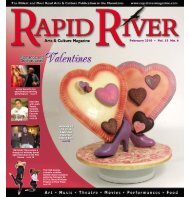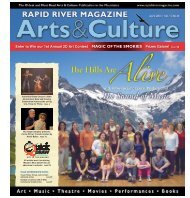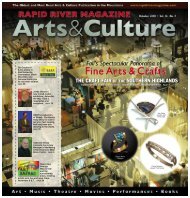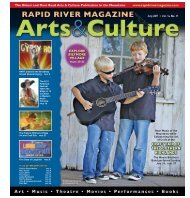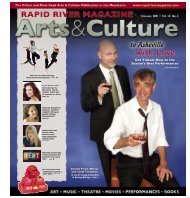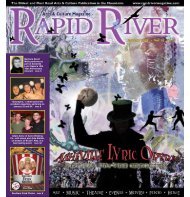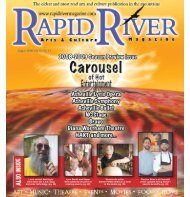JOHN MAC KAH - Rapid River Magazine
JOHN MAC KAH - Rapid River Magazine
JOHN MAC KAH - Rapid River Magazine
Create successful ePaper yourself
Turn your PDF publications into a flip-book with our unique Google optimized e-Paper software.
R A P I D R I V E R A R T S<br />
fine art<br />
INTERVIEW WITH<br />
John Mac Kah<br />
INTERVIEWED BY DENNIS RAY<br />
<strong>Rapid</strong> <strong>River</strong> <strong>Magazine</strong>: What led<br />
you to landscape painting and<br />
more importantly perhaps, what<br />
led you to capture landscapes<br />
through en plein air? (En plein air<br />
is a French expression that means literally<br />
“in the open air” and is particularly used to<br />
describe the act of painting outdoors)?<br />
John Mac Kah: When you come to my<br />
studio, you’ll find a lot of different subjects<br />
– from landscape to wild life, from portrait<br />
to fantasy and prehistoric life. But, landscape<br />
is my primary interest and is most<br />
rewarding. Plein-air is misunderstood.<br />
People think it means to paint quickly. Only<br />
outside can you find the truth in color and<br />
atmosphere.<br />
RRM: How would you<br />
describe your process?<br />
JMK: Depending on the<br />
complexity of the scene I<br />
like to get in two or three<br />
visits to a site. Sometimes<br />
I return as many as six<br />
times, working in the field.<br />
This is indirect painting<br />
(in layers) as opposed to<br />
direct painting (a la prima).<br />
This method yields more<br />
depth and texture and detail<br />
which I love.<br />
RRM: What kind of equipment<br />
do you use outside?<br />
JMK: The equipment varies<br />
between the traditional<br />
French ‘box” easel and an<br />
Italian style folding field<br />
easel. It depends on the<br />
Valley Cedars<br />
terrain and the weather. I<br />
sometimes take an umbrella<br />
to cut the glare and give me some shade.<br />
And stakes to tie down the rig if it becomes<br />
windy. Nothing worse than a canvas to pick<br />
up a wind like a sail, then land in the sand.<br />
RRM: What is your primary goal in painting<br />
a particular location?<br />
JMK: Each location is unique like a person,<br />
so I try to get a meaningful portrait of the<br />
site, and its peculiar mood, detail and energy.<br />
Cold Mountain (in Haywood County)<br />
has always had a strong energy that I felt<br />
when painting. I’ve painted it about seven<br />
times from various locations.<br />
RRM: What advice do you give your students<br />
to help them become better landscape<br />
painters?<br />
JMK: I try to emphasize the importance of<br />
on location studies on gessoed paper, instead<br />
Highland View<br />
by John Mac Kah<br />
Valley Cedars by John Mac Kah<br />
John Mac Kah working en plein air<br />
of the ‘make a masterpiece-the-first-timenotion’.<br />
John Singer Sargent said, “…paint<br />
100 heads.” The same can be said for landscape…or<br />
anything else.<br />
RRM: What is your approach<br />
to using on-site<br />
sketches to develop larger<br />
studio pieces?<br />
JMK: Again, small intimate<br />
studies to create a bank<br />
of information and true<br />
feeling for the area or time<br />
of day, which can easily be<br />
lost in a larger version.<br />
RRM: Of all the plein air<br />
paintings you’ve done,<br />
which is your favorite and<br />
why?<br />
JMK: Favorite painting? A<br />
vacant lot across from my<br />
house full of chicory in<br />
bloom with Queen Anne’s<br />
lace. It had truth in it.<br />
RRM: What is your<br />
philosophy on the artist’s<br />
connection to nature?<br />
JMK: All truth and beauty comes from<br />
Nature. Period. My favorite quote is from Li<br />
Po, “Cherish the land no one owns…”<br />
RRM: What is the most unusual thing that<br />
has ever happened to you while you were<br />
outside painting?<br />
JMK: Many things come to mind. Two,<br />
though stand out. We were painting in central<br />
Florida on Hontoon, an old shell midden,<br />
and came across a beautiful coral snake<br />
when preparing a camp site. And when at<br />
Huntington Island, SC a river otter confidently<br />
trotted through the area where I was<br />
painting on the beach near the light house,<br />
ignoring me completely.<br />
RRM: Your style carries very well throughout<br />
all of your work. How do you balance<br />
plein air painting with your studio work?<br />
Continued on page 6<br />
Vol. 14, No. 9 — RAPID RIVER ARTS & CULTURE MAGAZINE — May 2011 3




